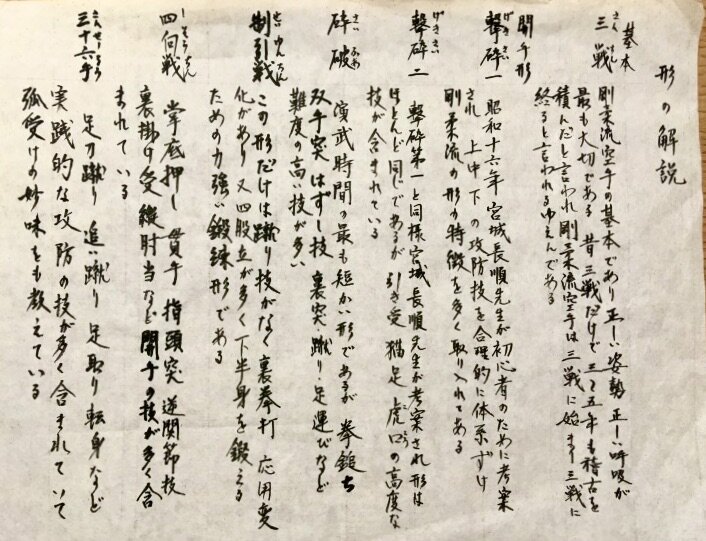Akihiko Suzuki-sensei's Kata Explanations
/As most dedicated practitioners will know, the essence of karate lies within its kata. Kata (形, or 型), meaning ‘form’, are a collection of martial art skills sequenced into a pattern, concealed in which lie the techniques that practitioners much analyse (“bunkai”) to discover their practical applications (see this blog post for insights into this).
The following is an explanation of the Goju-ryu kata that Akihiko Suzuki-sensei wrote during his time training at the Jundokan.
Akihiko Suzuki (Jan 11, 1934 — Mar 29, 2009) was a skilled disciple of Ei’ichi Miyazato-sensei who, after training at the Jundokan for many years, emigrated to the mainland where he was the first instructor to teach authentic Okinawa Goju-ryu in western Japan.
These are Suzuki-sensei’s original writings explaining each Goju-ryu kata (taken from this website):
I will provide the Japanese text and my own original English translations for Suzuki-sensei’s explanations below:
形の種類と名称
(基本)
(1) 三戦 (さんちん)
沖縄剛柔流空手の基本であり、正しい姿勢、正しい呼吸が最も大切である。昔三戦だけで3~5年も稽古を積んだと言われ、剛柔流空手は三戦に始まり三戦に終わると言われる所以である。
Kata types and names
(Kihon)
(1) Sanchin (Three Battles)
This is the foundation of Okinawa Goju-ryu Karate, in which correct posture and correct breathing are most important. It is said that students practiced Sanchin for three to five years in the past, and Goju-ryu karate is said to start and end with Sanchin.
(開手形)
(2) 撃砕一 (げきさいいち)
昭和16年宮城長順先生が初心者の為に考案され、上中下の攻防技を合理的に体系づけ、剛柔流の形の特徴を多く取り入れてある。
(Kaishugata)
(2) Gekisai-ichi (Attack and Destroy 1)
Chojun Miyagi-sensei created this kata for beginners in 1941, rationally systematising the upper, middle, and lower offense and defense techniques, and incorporating many features of the Goju-ryu kata.
(3) 撃砕二 (げきさいに)
撃砕第一と同様宮城長順先生が考案され、形はほとんど同じであるが引き受け、猫足、虎口の高度な技が含まれている。
(3) Gekisai-ni (Attack and Destroy 2)
This kata was created by Miyagi-sensei in the same way as gekisai dai-ichi, and is almost the same, but it includes advanced techniques such as hiki-uke (open-hand pull block), neko-ashi (cat-foot stance), and tora-guchi (tiger mouth).
(4) 砕破 (さいふあ)
演武時間の最も短い形であるが、拳鎚打ち、双手突き、外し技、裏突き、蹴り、足運び等難度の高い技が多い。
(4) Saifa (Smash and Tear)
This is the kata with the shortest performance time, but there are many difficult techniques such as tetsui-uchi (hammer-fist), morote-tsuki (double strike), hazushi-waza (escapes), ura-tsuki (inverted close punch), keri (kicking), and ashi-hakobi (footwork).
(5) 制引戦 (せいゆんちん)
この形だけは蹴り技が無く、裏拳打ち応用変化があり、また四股立ちが多く下半身を鍛える為の力強い鍛練形である。
(5) Seiyunchin (Control and Pull into Battle)
Only this kata has no kicking techniques. There are practical transformations such as uraken-uchi (back fist strikes), and it is a powerful training form to develop the lower-half of the body with many instances of shiko-dachi.
(6) 四向戦 (しそうちん)
掌底押し、貫手指頭突き、逆関節技、裏掛け受け、縦肘当てなど開手の技が多く含まれている。
(6) Shisochin (Fight in Four Directions)
There are many open-hand techniques such as shote-oshi (palm-strike), nukite-shito (finger strike), gyaku kansetsu-gi (breaks), ura kake-uke (reverse hook block), and tate hiji-atate (vertical elbow strike).
(7) 三十六手 (さんせーるう)
足刀蹴り、追い蹴り、足取り、転身など実戦的な攻防の技が多く含まれていて弧受けの妙味をも教えている。
(7) Sanseru (Thirty-six Hands)
This kata includes many practical offence and defence techniques such as sokuto-geri (heel kick), oi-geri (lunge kick), ashi-dori (leg grab), and tenshin (evasive body movement), and teaches the subtle point of ko-uke (AKA koken-uke, the wrist-joint block).
(8) 十ハ手 (せーぱい)
裏拳突き、裏拳打ち、拳鎚打ちなど接近戦に対処する打撃技、外し技など効果的な護身術が多く含まれている。また高度な欺瞞の術も含まれている。
(8) Sepai (Eighteen Hands)
There are many effective self-defence techniques in this kata, such as uraken-tsuki and uraken-uchi (back fist strikes), tetsui-uchi (hammer fist) and other striking techniques to deal with close combat, as well as escape techniques. It also includes high-level deception techniques.
(9) 久留頓破 (くるるんふあ)
交差受け、膝蹴り受け、ハンマー投げなど猫の様に素早い動きと粘りある動きが調和され極めにくい動作を一挙にして極めるところに特徴がある。
(9) Kurunfa (Holding on Long and Suddenly Striking)
This kata is characterised by quick movements and sticky movements, such as kosa-uke (AKA jyuji-uke, the crossing block), hiza geri-uke (knee kick block), and hanmaa-nage (hammer throw), which are difficult to master and preform harmoniously at once.
(10) 十三手 (せーさん)
ゆっくりとした動作から素早い足捌きの動作に移り、突き受けの連続技があり、剛と柔が調和された変化のある形である。
(10) Sesan (Thirteen Hands)
This is a kata that shifts from slow motions to quick footwork, has a series of tsuki-uke (striking block) techniques, and changes that harmonise the ‘go’ (hardness) and ‘ju’ (softness).
(11) 壱百零八手 (すうぱありんぺい)(ぺっちゅうりん)
別名ぺっちゅうりんとも言う、上・中・下の三つの形で構成されていたと伝えられる。現在の壱百零八手は上で剛柔流の形で最も長く四方八方へ多彩の技を駆使し遅速緩急が多く非常に妙味があり魅力がある。剛柔流の奥義が伺える形である。
(11) Suparinpei (One Hundred Eight Hands)
This kata is also called Pecchurin. It is said that it was composed of three forms: upper, middle, and lower. The current Suparinpei is the longest of the Goju-ryu katas, making full use of various techniques in all directions, with many different speeds and has a lot of charm and attraction. It is a kata in which one can discover the hidden purpose of Goju-ryu.
(閉手形)
(12) 転掌 (てんしょう)
宮城長順先生が大正4年に中国拳法を研究する目的で福建省福州を訪ねた際、南派少林拳白鶴拳の六合壱機手(略して六機手)を研究されて考案し閉手形とした。臍下丹田に力を集中し気息体の修練を目的とすることは三戦と全く同じである。正しい姿勢と呼吸によって開掌で各種の受け方、掌底の当て方などを体得する。
(Heishugata)
(12) Tensho (Revolving Palms)
When Miyagi Chojun-sensei visited Fuzhou in the Fujian Province to study Chinese kempo in 1915, he learnt the Southern School Shaolin White Crane Boxing's ‘Rokugo Ikkishu’ (shortened to Rokkishu) and devised the heishugata. It is exactly the same as Sanchin, with the aim of concentrating power on the stomach’s navel and training one’s breathing. With the right posture and breathing, one can learn various ways of receiving and striking with the bottom of the palm with open hands.
Blake Turnbull copyright ©2020




